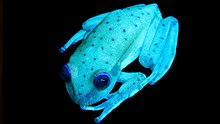en
names in breadcrumbs


The polka dot tree frog (Hypsiboas punctatus) is a small (3-3.5 centimeter body length), common, neotropical treefrog in the family Hylidae.Pale green in color, its smooth skin has variable markings and can be speckled with white, yellow or reddish spots, and red or white eyelid (Boulenger 1882).Its wide distribution covers altitudes up to 1,400 m over most of the Amazon basin, including the Guianas, Surinam, Venezuela, Columbia, Ecuador, Peru, Bolivia, Brazil, and along the Río Paraguay-Parana into northern Paraguay and Argentina.It also occurs on Trinidad and Tobago. There is historic taxonomic uncertainty surrounding this species, which may contain other cryptic species within it (La Marca et al. 2010).
Hypsiboas punctatus inhabits a multitude of environment types: primary and secondary tropical and dry forests, marshes and grasslands, and also does well in degraded environments, gardens and urban areas.Adults appear to be generalist feeders, foraging on available invertebrate prey, with inclinations for dipterans (Lopez et al. 2009).
In breeding season, frogs congregate in bodies of water.Males are aggressively territorial and use an extended vocal repertoire of seven different call types to advertise for females and guard their calling site.Males also have specialized skin glands for secreting pheromones during courtship, which may influence female choice strategies and also perhaps male-male interactions.Females lay sticky gelatinous batches of 10-15 eggs, which float as a monolayer on the water surface.An individual female lays a total up to about 300 eggs (Brunetti et al. 2014, 2015).
This frog sometimes appears in the pet trade, but IUCN reports this to be at sustainable levels (La Marca et al. 2010).
Calls can be heard at fonozoo: http://www.fonozoo.com/fnz_detalles_registro_amphibia.php?id=20146&tipo_registro=2, http://www.fonozoo.com/fnz_detalles_registro_amphibia.php?id=76108&tipo_registro=1
The polka-dot tree frog (Boana punctata), also known as the dotted tree frog, is a frog species in the family Hylidae found in much of South America and also in Trinidad and Tobago. It is fairly small with a snout–to–vent length of c. 3–4 cm (1.2–1.6 in).[1]
Its natural habitats are subtropical or tropical dry forest, subtropical or tropical moist lowland forest, subtropical or tropical swamps, subtropical or tropical moist montane forest, swamps, freshwater marshes, intermittent freshwater marshes, rural gardens, urban areas, and heavily degraded former forests. It is not considered threatened by the IUCN.[2]

In 2017, several polka-dot tree frogs collected in the Santa Fe Province in Argentina were the first amphibian, amongst more than 6,000 species of frog, identified as naturally fluorescent.[3][4][5] Among land-living vertebrates, it had only been confirmed earlier in certain parrots (as opposed to fish and invertebrates where fluorescence is relatively widespread).[3] A few months later, fluorescence was discovered in the closely related Hypsiboas atlanticus,[6] and in 2019 it was discovered in the distantly related pumpkin toadlet (Brachycephalus ephippium) and red pumpkin toadlet (B. pitanga).[7] In 2020, it was confirmed that fluorescence is relatively widespread among frogs and other amphibians.[8]
When exposed to ultra-violet light, the skin of the polka-dot tree frog emits a bright green fluorescent glow. The discovery was made accidentally when the researchers checked the skin secretions of the frog under UV light. They expected only a faint red fluorescence, because the frog skin contains biliverdin, a green tetrapyrrolic bile pigment responsible for its dull mottled browny-green colour.[9] The surprising green fluorescence is attributed to hyloin compounds, mainly hyloin-L1, hyloin-L2 and hyloin-G1.[3][4] These fluorescent molecules, in the dihydroisoquinolinone family and derived from the isoquinoline (a benzene ring fused to a pyridine ring), in an alkaloid protecting mucous membrane, have been identified in the lymph tissue, skin and glandular secretions of the frog.[3] Because it is linked to secretions from skin glands, they can also leave fluorescent markings on surfaces where they have been.[6]
The fluorescence intensity represents about 18−29% of the luminosity under twilight conditions and is suspected to play a possible role in the communication, camouflage and mating of the frog.[3]
The polka-dot tree frog (Boana punctata), also known as the dotted tree frog, is a frog species in the family Hylidae found in much of South America and also in Trinidad and Tobago. It is fairly small with a snout–to–vent length of c. 3–4 cm (1.2–1.6 in).
Its natural habitats are subtropical or tropical dry forest, subtropical or tropical moist lowland forest, subtropical or tropical swamps, subtropical or tropical moist montane forest, swamps, freshwater marshes, intermittent freshwater marshes, rural gardens, urban areas, and heavily degraded former forests. It is not considered threatened by the IUCN.